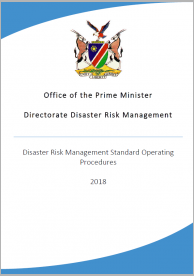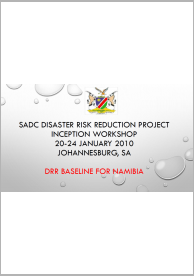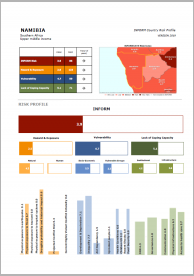Namibia is often affected by natural hazards, such as floods, droughts and desertification. These events combined with the HIV/AIDS pandemic, food insecurity and poverty, contribute to increasing the country’s vulnerability (CADRI, 2016).
The Prime Minister's Office is the highest-level responsible institution for DRR in the country. At the national level, the Directorate Disaster Risk Management (DDRM) coordinates DRM activities and the decisions of the National Disaster Risk Management Committee - an advisory body, with representatives of several Ministries and of the Association for Regional Councils or the Association for Local Authorities. There are Regional Disaster Management Risk Committees and Constituency DRM Committees, not all of them active (CADRI, 2016). At lower administrative levels, the DRM structures do not exist.
The Namibia Vulnerability Assessment Committee is responsible for collecting information and informing about vulnerability assessments.
The DRR legislative and institutional framework is aligned with international agreements such as the Sendai Framework (2015-2030) and the Africa Regional Strategy for DRR [CADRI Report (2016)], illustrating the paradigm shift from disaster response to a comprehensive DRM approach. The fact that DRR efforts are prioritised and supported by the DRM Plan (2011) and the positive language are some of the strengths of the framework (Powrie, 2014).
- CADRI. (2016). Capacity Assessment Report of the National Disaster Risk Management System in Namibia. Retrieved December 2019, from https://www.cadri.net/sites/default/files/Namibia-DRM-Capacity-Assess…
- Powrie, E. (2014). Namibia: Country Case Study Report. New York: UNDP
Namibia, formerly South-West Africa, has a sub-tropical climate, desert along the coast and in the south, and arid, but with a rainy season from November to March, in inland north-central areas and in the north-east.
The country is crossed by the Tropic of Capricorn, but a cold current, called the Benguela Current, flows along the coast, while the interior is occupied by a plateau. As a result, the climate is cooler and drier than you might think. Nevertheless, it can get hot in summer, especially at some distance from the sea and in areas located at not too high altitudes. There may be blistering days from September to March in the north, from November to January in Windhoek, which is located at a pretty high altitude, and from September to Avril or early May in the center-south. On the contrary, during winter, the plateau can get cold at night, with possible light frosts everywhere.
The driest region is the coastal area, where the Namib Desert is located, as well as the south, where the Kalahari Desert is found. The latter is slightly rainier, and it's home to xerophyte plants such as cacti and other succulent species. The rainiest area of Namibia is the north-east, where rainfall ranges from 500 to 600 millimeters per year. Winter is dry everywhere, while in non-desert regions (north and east) it rains in summer, from November to March, usually in the form of showers or thunderstorms in the afternoon. The peak of the rainy season is from January to March.

Regional Platform / DRR Contact Point
-
Government of NamibiaOrganization type:
Risk reduction Policies, Plans & Strategies
Policies, plans and official statements on disaster risk, climate adaptation and resilience.

|
Disaster Risk Management Standard Operating Procedures
The document outline standard operating procedures, integrating the context specificity of Namibia, and provides a practical understanding of its application. |

|
Namibia's Fifth National Development Plan (2017/18 - 2021/22)
The purpose of NDP5 to set out a roadmap for achieving rapid industrialization while adhering to the four integrated pillars of sustainable development: Economic Progression; Social Transformation; Environmental Sustainability; Good Governance. |

|
A Policy for Disaster Risk Management in Namibia
The policy seeks to outline a coherent, transparent and inclusive policy on disaster risk management appropriate for the Government of the Republic of Namibia as a whole with a proportionate emphasis on disasters of different kinds, severity and magnitude that occur or may occur in Namibia. |
Documents & Publications
Disaster risk reduction and resilience publications, reports, research papers and case studies.

|
SADC Disaster Risk Reduction Project Inception Workshop | DRR Baseline for Namibia
Namibia presentation in the Strengthening Disaster Risk Reduction, Coordination, Planning and Policy Advisory Capacity of SADC Project Inception Workshop, held in Johannesburg, South Africa, 20-24 January 2020. |

|
RIASCO Humanitarian Outlook for Southern Africa | November 2017-April 2018
This report analyses some of the southern african countries readiness to humanitarian impacts related to their macro-economic conditions, the regional seasonal rainfall forecast, the food, livelihood and nutrition security and the conflict in Democratic Republic of Congo. |

|
Report on the RIASCO Action Plan for the El Niño-Induced Drought in Southern Africa 2016/2017
This document describes the main results of the Regional Inter-Agency Standing Committee (RIASCO) Action Plan for the El Niño-Induced Drought in Southern Africa 2016/2017. |
Disaster Data & Statistics
Reports on disaster statistics, country profiles and additional resources on collecting disaster loss data.

|
Disaster Risk Profile - Namibia
This country risk profile for Namibia provides a comprehensive view of hazard, risk and uncertainties for floods and droughts in a changing climate, with projections for the period 2050-2100. |

|
INFORM Country Risk Profile - Namibia
Index for Risk Management. |

